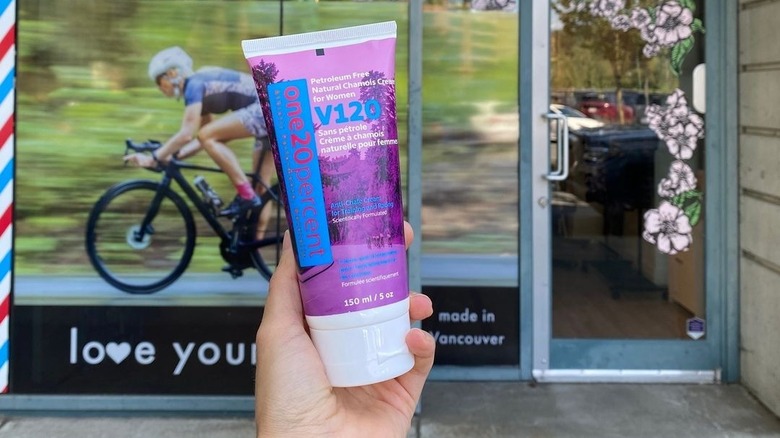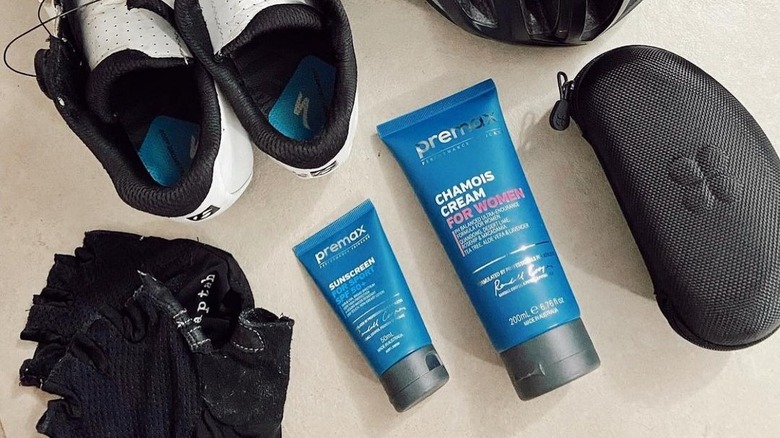What Is Chamois Cream And What Can It Do For Your Cycling Workout?
We may receive a commission on purchases made from links.
Cycling can do wonders for our health, whether we're talking about mountain biking, spin classes, or indoor cycling. Riding a bike every day may lead to increased core strength, lower cholesterol levels, and better sleep, among other benefits. The problem is that you might also end up with a rash or other skin problems in sensitive areas. Saddle sores, chafing, bruising, and infections are all common.
"Today, I started bleeding after my ride. From the place you don't want to bleed from. The kind of bleeding you only discover on two-ply paper," confessed a Reddit user. Most people who saw the thread told him to wear padded shorts, apply chamois cream, or get a new saddle. Chamois cream may also help with saddle sores, suggests a 2022 review featured in the International Journal of Environmental Research and Public Health. This product reduces friction against the saddle, preventing chafing and other related issues.
Chamois cream isn't a cure-all, but it can make your bike more comfortable. Some say it's a lifesaver during long rides and hour-long spin classes. Plus, it's budget-friendly and works on most skin types. The challenge lies in choosing a brand that meets your needs.
Why you should use chamois cream before hopping on a bike
The term "chamois" doesn't refer to a specific product or ingredient. It's typically used to describe the padding in bike seats or cycling shorts. Chamois cream can prevent rubbing between your skin and the bike seat, which may help reduce blisters, sores, rashes, and other issues. Basically, it acts as a barrier between your private parts and the surface you're sitting on. Depending on its composition, chamois cream may also inhibit bacterial growth, produce a cooling effect, or moisturize your skin.
A popular choice is the Chamois Butt'r Original Anti-Chafe Cream, which can be applied to any area prone to chafing. Not only does it reduce friction, but it also soothes irritated skin and may prevent saddle soreness. The same brand offers a formula designed specifically for women, which contains tea tree oil, aloe vera, shea butter, and other ingredients suitable for sensitive skin. Plus, it has no fragrances, parabens, or synthetic dyes. You may also try the Muc-Off Chamois Cream, a paraben-free formula that hydrates and cools the skin, keeping you comfortable during long rides.
Ideally, look for products with aloe vera, witch hazel, and moisturizing ingredients like coconut oil or shea butter. These are some of the best solutions for chafing, and they become even more effective when used together. For example, coconut oil has antibacterial and antifungal properties, while witch hazel may relieve itching and skin irritation.
When and how to apply chamois cream
Depending on your preferences, you can apply chamois cream directly to your skin or to the padding in your cycling shorts. Make sure your hands are clean, and then apply the product to your buttocks, inner thighs, or any other areas where you experience chafing. Most creams can also be used on the perineum, under the breasts, or around your private parts. "I apply chamois cream on the padded shorts directly, in the areas that come into contact with the vulva, as well as on the labia itself," gynecologist Pradnya Pisal told Cycling UK.
For best results, apply it before hopping on your bike. If you're preparing for a longer ride, take the cream with you and reapply it as needed. Massage it into your skin for a minute or two, and then put on your cycling shorts. Wash it off with water when you're back home. Note that some formulas contain menthol or other ingredients that may cause a mild burning sensation. These may not be suitable for your private areas, but you can apply them to your sitting bones or inner thighs.
If you ever run out of chamois cream, consider using coconut oil, petroleum jelly, or baby powder. For example, Vaseline is one of the best petroleum jelly products for your skin due to its moisturizing and healing properties. Although it doesn't protect against bacteria and fungi, it may help prevent chafing and soothe dryness.


